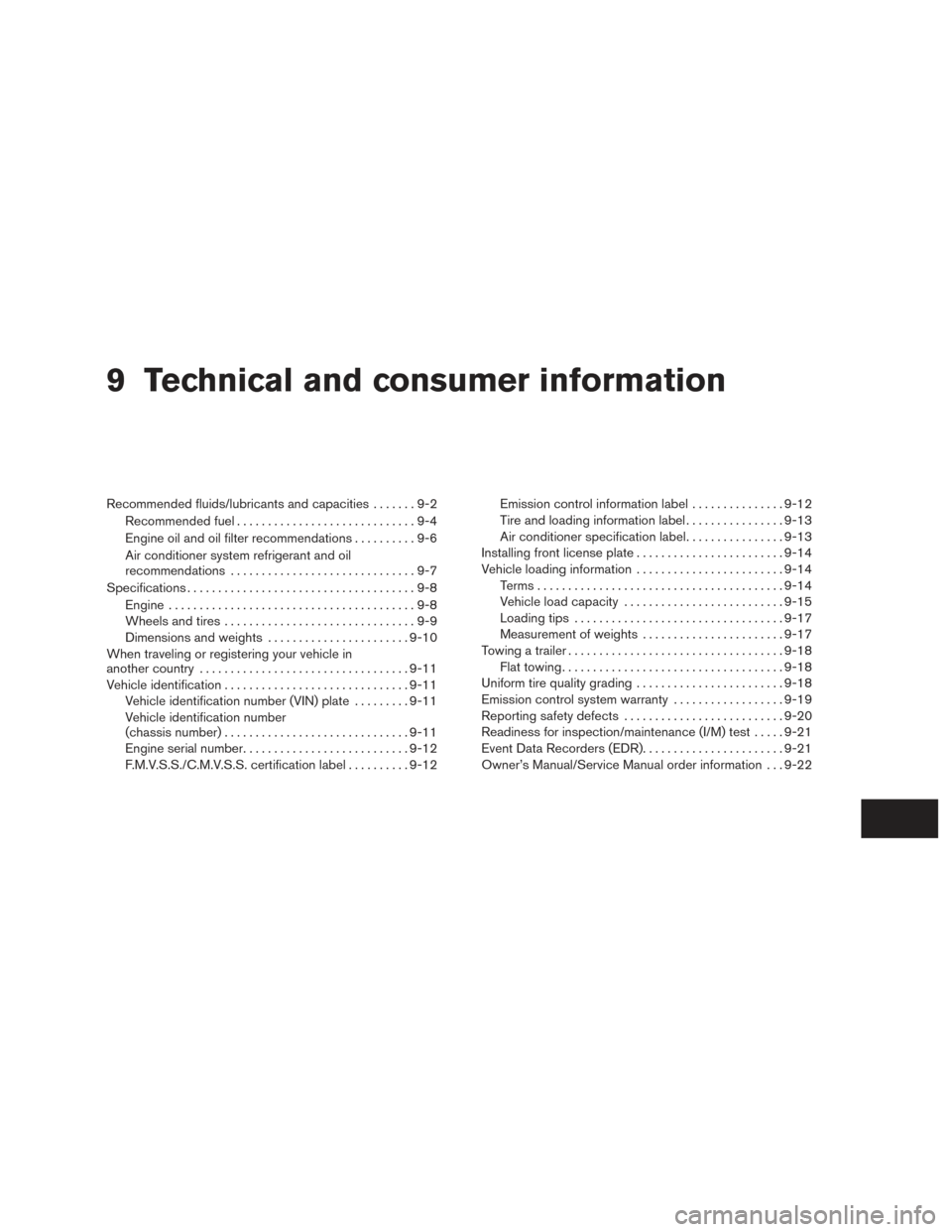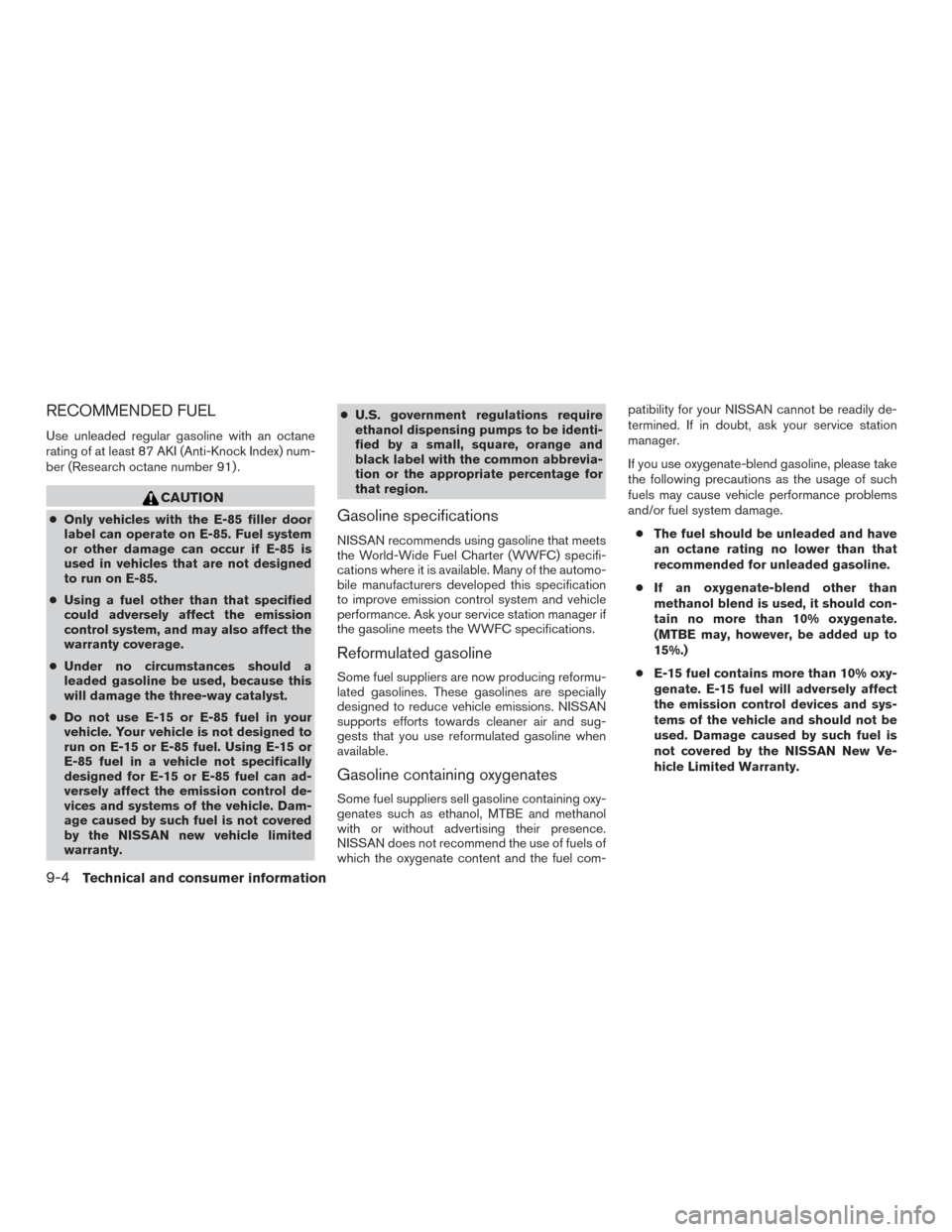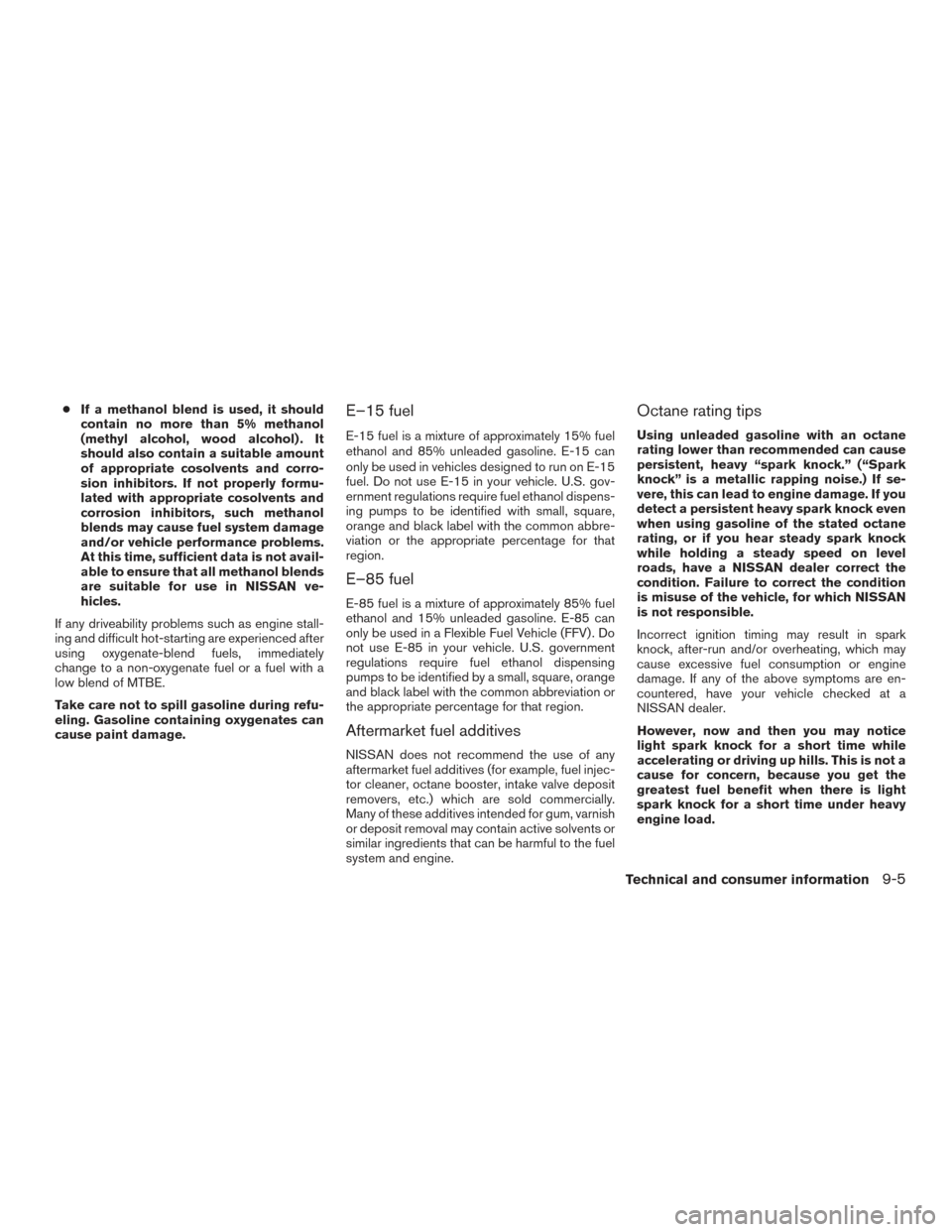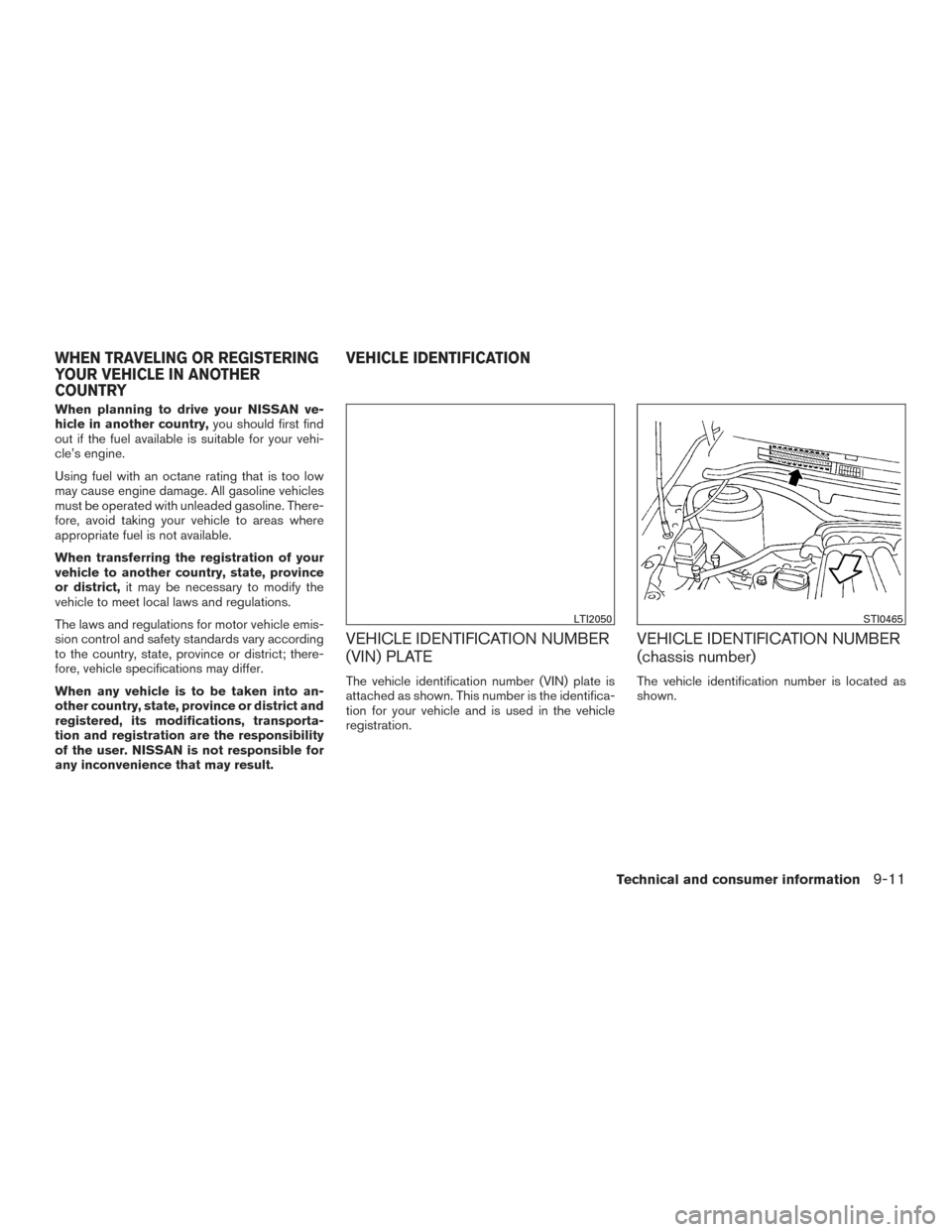2015 NISSAN SENTRA fuel
[x] Cancel search: fuelPage 372 of 402

9 Technical and consumer information
Recommended fluids/lubricants and capacities.......9-2
Recommended fuel .............................9-4
Engine oil and oil filter recommendations ..........9-6
Air conditioner system refrigerant and oil
recommendations ..............................9-7
Specifications .....................................9-8
Engine ........................................9-8
Wheels and tires ...............................9-9
Dimensions and weights .......................9-10
When traveling or registering your vehicle in
another country .................................. 9-11
Vehicle identification .............................. 9-11
Vehicle identification number (VIN) plate .........9-11
Vehicle identification number
(chassis number) .............................. 9-11
Engine serial number ........................... 9-12
F.M.V.S.S./C.M.V.S.S. certification label ..........9-12 Emission control information label
...............9-12
Tire and loading information label ................9-13
Air conditioner specification label ................9-13
Installing front license plate ........................9-14
Vehicle loading information ........................9-14
Terms ........................................ 9-14
Vehicle load capacity .......................... 9-15
Loading tips .................................. 9-17
Measurement of weights .......................9-17
Towing a trailer ................................... 9-18
Flat towing .................................... 9-18
Uniform tire quality grading ........................9-18
Emission control system warranty ..................9-19
Reporting safety defects .......................... 9-20
Readiness for inspection/maintenance (I/M) test .....9-21
Event Data Recorders (EDR) .......................9-21
Owner’s Manual/Service Manual order information . . . 9-22
Page 373 of 402

The following are approximate capacities. The actual refill capacities may be slightly different. When refilling, follow the procedure
described in the “Maintenance and do-it-yourself” section to determine the proper refill capacity.
Capacity (Approximate)Recommended Fluids and Lubricants
US measure Imp measure Liter
Fuel 13-1/4 gal11 gal50 L • For additional information, refer to “Recommended fuel” in this section.
Engine oil Drain and refill• For additional information, refer to “Changing engine oil” in the “Mainte-
nance and do-it-yourself” section.
MRA8DE With oil filter
change 4-1/4 qt
3-1/2 qt4.0 L• Engine oil with API Certification Mark.
• Viscosity SAE 0W-20.
• For additional information, refer to “Engine oil and oil filter recommenda-
tions” in this section.
• As an alternative to this recommended oil, SAE 5W-30 conventional
petroleum based oil may be used and meets all specifications and re-
quirements necessary to maintain the New Vehicle Limited Warranty.
Without oil
filter change 4 qt
3-3/8 qt3.8 L
Cooling system With reservoir 1-3/4 gal 1-1/2 gal6.6 L • Pre-diluted Genuine NISSAN Long Life Antifreeze/Coolant (blue) or
equivalent.
Manual transmission fluid ———• Genuine NISSAN Manual Transmission Fluid (MTF) TL/JR Type
75W-80, or equivalent.
• If Genuine NISSAN Manual Transmission Fluid (MTF) TL/JR Type is not
available, API GL-4+, Viscosity SAE 75W-80 may be used as a tempo-
rary replacement. However, use Genuine NISSAN Manual Transmission
Fluid (MTF) TL/JR Type as soon as it is available.
• If Genuine NISSAN Manual Transmission Fluid (MTF) TL/JR Type is not
available, API GL-4+, Viscosity SAE 75W-80 may be used as a tempo-
rary replacement. However, use Genuine NISSAN Manual Transmission
Fluid (MTF) TL/JR Type as soon as it is available.
RECOMMENDED FLUIDS/
LUBRICANTS AND CAPACITIES
9-2Technical and consumer information
Page 375 of 402

RECOMMENDED FUEL
Use unleaded regular gasoline with an octane
rating of at least 87 AKI (Anti-Knock Index) num-
ber (Research octane number 91) .
CAUTION
●Only vehicles with the E-85 filler door
label can operate on E-85. Fuel system
or other damage can occur if E-85 is
used in vehicles that are not designed
to run on E-85.
● Using a fuel other than that specified
could adversely affect the emission
control system, and may also affect the
warranty coverage.
● Under no circumstances should a
leaded gasoline be used, because this
will damage the three-way catalyst.
● Do not use E-15 or E-85 fuel in your
vehicle. Your vehicle is not designed to
run on E-15 or E-85 fuel. Using E-15 or
E-85 fuel in a vehicle not specifically
designed for E-15 or E-85 fuel can ad-
versely affect the emission control de-
vices and systems of the vehicle. Dam-
age caused by such fuel is not covered
by the NISSAN new vehicle limited
warranty. ●
U.S. government regulations require
ethanol dispensing pumps to be identi-
fied by a small, square, orange and
black label with the common abbrevia-
tion or the appropriate percentage for
that region.Gasoline specifications
NISSAN recommends using gasoline that meets
the World-Wide Fuel Charter (WWFC) specifi-
cations where it is available. Many of the automo-
bile manufacturers developed this specification
to improve emission control system and vehicle
performance. Ask your service station manager if
the gasoline meets the WWFC specifications.
Reformulated gasoline
Some fuel suppliers are now producing reformu-
lated gasolines. These gasolines are specially
designed to reduce vehicle emissions. NISSAN
supports efforts towards cleaner air and sug-
gests that you use reformulated gasoline when
available.
Gasoline containing oxygenates
Some fuel suppliers sell gasoline containing oxy-
genates such as ethanol, MTBE and methanol
with or without advertising their presence.
NISSAN does not recommend the use of fuels of
which the oxygenate content and the fuel com- patibility for your NISSAN cannot be readily de-
termined. If in doubt, ask your service station
manager.
If you use oxygenate-blend gasoline, please take
the following precautions as the usage of such
fuels may cause vehicle performance problems
and/or fuel system damage.
● The fuel should be unleaded and have
an octane rating no lower than that
recommended for unleaded gasoline.
● If an oxygenate-blend other than
methanol blend is used, it should con-
tain no more than 10% oxygenate.
(MTBE may, however, be added up to
15%.)
● E-15 fuel contains more than 10% oxy-
genate. E-15 fuel will adversely affect
the emission control devices and sys-
tems of the vehicle and should not be
used. Damage caused by such fuel is
not covered by the NISSAN New Ve-
hicle Limited Warranty.
9-4Technical and consumer information
Page 376 of 402

●If a methanol blend is used, it should
contain no more than 5% methanol
(methyl alcohol, wood alcohol) . It
should also contain a suitable amount
of appropriate cosolvents and corro-
sion inhibitors. If not properly formu-
lated with appropriate cosolvents and
corrosion inhibitors, such methanol
blends may cause fuel system damage
and/or vehicle performance problems.
At this time, sufficient data is not avail-
able to ensure that all methanol blends
are suitable for use in NISSAN ve-
hicles.
If any driveability problems such as engine stall-
ing and difficult hot-starting are experienced after
using oxygenate-blend fuels, immediately
change to a non-oxygenate fuel or a fuel with a
low blend of MTBE.
Take care not to spill gasoline during refu-
eling. Gasoline containing oxygenates can
cause paint damage.E–15 fuel
E-15 fuel is a mixture of approximately 15% fuel
ethanol and 85% unleaded gasoline. E-15 can
only be used in vehicles designed to run on E-15
fuel. Do not use E-15 in your vehicle. U.S. gov-
ernment regulations require fuel ethanol dispens-
ing pumps to be identified with small, square,
orange and black label with the common abbre-
viation or the appropriate percentage for that
region.
E–85 fuel
E-85 fuel is a mixture of approximately 85% fuel
ethanol and 15% unleaded gasoline. E-85 can
only be used in a Flexible Fuel Vehicle (FFV) . Do
not use E-85 in your vehicle. U.S. government
regulations require fuel ethanol dispensing
pumps to be identified by a small, square, orange
and black label with the common abbreviation or
the appropriate percentage for that region.
Aftermarket fuel additives
NISSAN does not recommend the use of any
aftermarket fuel additives (for example, fuel injec-
tor cleaner, octane booster, intake valve deposit
removers, etc.) which are sold commercially.
Many of these additives intended for gum, varnish
or deposit removal may contain active solvents or
similar ingredients that can be harmful to the fuel
system and engine.
Octane rating tips
Using unleaded gasoline with an octane
rating lower than recommended can cause
persistent, heavy “spark knock.” (“Spark
knock” is a metallic rapping noise.) If se-
vere, this can lead to engine damage. If you
detect a persistent heavy spark knock even
when using gasoline of the stated octane
rating, or if you hear steady spark knock
while holding a steady speed on level
roads, have a NISSAN dealer correct the
condition. Failure to correct the condition
is misuse of the vehicle, for which NISSAN
is not responsible.
Incorrect ignition timing may result in spark
knock, after-run and/or overheating, which may
cause excessive fuel consumption or engine
damage. If any of the above symptoms are en-
countered, have your vehicle checked at a
NISSAN dealer.
However, now and then you may notice
light spark knock for a short time while
accelerating or driving up hills. This is not a
cause for concern, because you get the
greatest fuel benefit when there is light
spark knock for a short time under heavy
engine load.
Technical and consumer information9-5
Page 377 of 402

ENGINE OIL AND OIL FILTER
RECOMMENDATIONS
Selecting the correct oil
It is essential to choose the correct grade, quality
and viscosity engine oil to ensure satisfactory
engine life and performance. For additional infor-
mation, refer to “Recommended fluids/lubricants
and capacities” in this section. NISSAN recom-
mends the use of an energy conserving oil in
order to improve fuel economy.
Select only engine oils that meet the American
Petroleum Institute (API) certification or Interna-
tional Lubricant Standardization and ApprovalCommittee (ILSAC) certification and SAE vis-
cosity standard. These oils have the API certifica-
tion mark on the front of the container. Oils which
do not have the specified quality label should not
be used as they could cause engine damage.Oil additives
NISSAN does not recommend the use of oil
additives. The use of an oil additive is not neces-
sary when the proper oil type is used and main-
tenance intervals are followed.
Oil which may contain foreign matter or has been
previously used should not be used.
Oil viscosity
The engine oil viscosity or thickness changes
with temperature. Because of this, it is important
to select the engine oil viscosity based on the
temperatures at which the vehicle will be oper-
ated before the next oil change. Choosing an oil
viscosity other than that recommended could
cause serious engine damage.
Selecting the correct oil filter
Your new NISSAN vehicle is equipped with a
high-quality Genuine NISSAN oil filter. When
replacing, use a Genuine NISSAN oil filter or its
equivalent for the reason described in “Change
intervals.”
Change intervals
The oil and oil filter change intervals for your
engine are based on the use of the specified
quality oils and filters. Using engine oil and filters
that are not of the specified quality, or exceeding
recommended oil and filter change intervals
could reduce engine life. Damage to the engine
caused by improper maintenance or use of incor-
rect oil and filter quality and/or viscosity is not
covered by the NISSAN New Vehicle Limited
Warranty.
LTI2051
9-6Technical and consumer information
Page 382 of 402

When planning to drive your NISSAN ve-
hicle in another country,you should first find
out if the fuel available is suitable for your vehi-
cle’s engine.
Using fuel with an octane rating that is too low
may cause engine damage. All gasoline vehicles
must be operated with unleaded gasoline. There-
fore, avoid taking your vehicle to areas where
appropriate fuel is not available.
When transferring the registration of your
vehicle to another country, state, province
or district, it may be necessary to modify the
vehicle to meet local laws and regulations.
The laws and regulations for motor vehicle emis-
sion control and safety standards vary according
to the country, state, province or district; there-
fore, vehicle specifications may differ.
When any vehicle is to be taken into an-
other country, state, province or district and
registered, its modifications, transporta-
tion and registration are the responsibility
of the user. NISSAN is not responsible for
any inconvenience that may result.
VEHICLE IDENTIFICATION NUMBER
(VIN) PLATE
The vehicle identification number (VIN) plate is
attached as shown. This number is the identifica-
tion for your vehicle and is used in the vehicle
registration.
VEHICLE IDENTIFICATION NUMBER
(chassis number)
The vehicle identification number is located as
shown.
LTI2050STI0465
WHEN TRAVELING OR REGISTERING
YOUR VEHICLE IN ANOTHER
COUNTRY VEHICLE IDENTIFICATION
Technical and consumer information9-11
Page 395 of 402

Brakes......................8-21
Brake system ...................5-30
Break-in schedule ................5-26
Brightness/contrastbutton............4-9
Brightness control Instrument panel ...............2-29
Bulb check/instrument panel ..........2-15
Bulb replacement ................8-33
C
Capacities and recommended fuel/lubricants . .9-2
Cargonet.....................2-40
Cargo(Seevehicleloadinginformation)....9-14
Car phone or CB radio .............4-66
CD care and cleaning ..............4-63
CD player (See audio system) . .4-39, 4-44, 4-51
Child restraints .......1-16,1-17,1-18,1-20
LATCH (Lower Anchors and Tethers for
CHildren) System ..............1-20
Precautions on child
restraints.........1-18,1-24,1-30,1-34
Top tether strap anchor point locations . .1-22
Child safety rear door lock ............3-6
Chimes, audible reminders ...........2-22
Cleaningexteriorandinterior...........7-2
Clock set/adjustment ...........4-7,4-37
Clock setting
(models with Navigation System) ........4-7
Clock setting
(models without Navigation System) ......4-42
Clutch Clutch fluid ..................8-13
C.M.V.S.S. certification label ..........9-12
Cold weather driving ...............5-34 Compact disc (CD) player
....4-39,4-44,4-51
Connect phone .................4-66
Console box ...................2-38
Console light ...................2-46
Continuously Variable Transmission (CVT) . . .5-16 Continuously Variable Transmission (CVT)
fluid......................8-12
Driving with Continuously Variable
Transmission (CVT) .............5-16
Control panel buttons ...............4-4
Back button ..................4-7
Brightness/contrast button ..........4-9
Enterbutton..................4-4
Setting button .............4-7,4-37
Controls Audio controls (steering wheel) .......4-64
Heater and air conditioner controls .....4-25
Heater and air conditioner controls
(manual) ...................4-16
Coolant Capacities and recommended
fuel/lubricants .................9-2
Changingenginecoolant...........8-9
Checking engine coolant level ........8-9
Engine coolant temperature gauge .....2-6
Corrosion protection ...............7-6
Cruisecontrol..................5-24
Cupholders...................2-37
Curtain side-impact air bag system
(See supplemental side air bag and curtain
side-impact air bag system) ...........1-52
D
Daytime light system ...............2-29 Defroster switch
Rearwindowdefrosterswitch .......2-27
Dimensionsandweights ............9-10
Dimmer switch for instrument panel ......2-29
Display controls (see control panel buttons) . .4-4
Door open warning light .............2-16
Doors ........................3-4
Drive belt .....................8-17
Driving Cold weather driving .............5-34
Driving with Continuously Variable
Transmission (CVT) .............5-16
Driving with manual transmission ......5-20
Precautions when starting and driving ....5-2
Driving the vehicle ................5-16
E
E
conomy-fuel..................5-28
Emergency engine shutoff ............5-12
Emission control information label .......9-12
Emission control system warranty .......9-19
Engine Before starting the engine ..........5-14
Blockheater.................5-35
Capacities and recommended
fuel/lubricants.................9-2
Changing engine coolant ...........8-9
Changingengineoil.............8-11
Changing engine oil filter ..........8-12
Checking engine coolant level ........8-9
Checking engine oil level ..........8-10
Engine compartment check locations ....8-7
Engine coolant temperature gauge .....2-6
Engine cooling system ............8-8
10-2
Page 396 of 402

Engine oil...................8-10
Engine oil and oil filter recommendation . . .9-6
Engine oil pressure warning light ......2-16
Engine oil viscosity ..............9-6
Engine serial number ............9-12
Engine specifications .............9-8
Starting the engine ..........5-14,5-15
Engine coolant temperature gauge .......2-6
Enterbutton....................4-4
Event data recorders ..............9-21
Exhaust gas (Carbon monoxide) .........5-2
Explanation of maintenance items ........8-2
Extendedstorageswitch ............8-25
Eyeglass case ..................2-36
F
Flashers (See hazard warning flasher switch) . .6-2
Flat tire .......................6-3
Floor mat positioning aid .............7-5
Fluid Brake fluid ..................8-13
Capacities and recommended
fuel/lubricants .................9-2
Clutchfluid..................8-13
Continuously Variable Transmission (CVT)
fluid......................8-12
Engine coolant .................8-8
Engine oil ...................8-10
F.M.V.S.S. certification label ...........9-12
Foglightswitch .................2-30
Front air bag system
(See supplemental restraint system) ......1-44
Frontseats.....................1-2 Fuel
Capacities and recommended
fuel/lubricants .................9-2
Fuel economy ................5-28
Fuel-filler cap .................3-25
Fuel-filler door lock opener lever ......3-25
Fuel-filler lid .................3-25
Fuel gauge ...................2-7
Fuel octane rating ...............9-5
Fuel recommendation .............9-4
Loose fuel cap warning ............2-5
Fuel Cell Vehicle (FCV) System Tirepressure.................8-35
Fuel-filler door ..................3-25
Fuelgauge.....................2-7
Fuses.......................8-22
Fusiblelinks ...................8-23
G
Garage door opener, HomeLink® Universal
Transceiver . .2-47, 2-48, 2-49, 2-50, 2-50, 2-51
Gascap .....................3-25
Gauge Engine coolant temperature gauge .....2-6
Fuel gauge ...................2-7
Odometer ...................2-4
Speedometer .................2-4
Tachometer ..................2-6
Trip computer .................2-8
Trip odometer .................2-4
General maintenance ...............8-2
Glovebox.....................2-38 H
Hazard warning flasher switch ..........6-2
Headlightandturnsignalswitch........2-27
Headlightcontrolswitch ............2-27
Headlights....................8-29
Head restraints ..................1-5
Heated seats ...................2-31
Heater Heater and air conditioner (automatic)
(if so equipped) ...............4-24
Heater and air conditioner controls .....4-25
Heater operation ...........4-18,4-26
Heater and air conditioner (automatic) .....4-24
HomeLink®
Universal
Transceiver . .2-47, 2-48, 2-49, 2-50, 2-50, 2-51
Hood.......................3-23
Horn .......................2-31
I
Ignition switch ...................5-8
Ignition Switch Push-Button Ignition Switch ........5-10
Immobilizer system .........2-24,5-10,5-13
Important vehicle information label .......9-12
In-cabin microfilter ................8-19
Increasing fuel economy .............5-28
Indicator lights and audible reminders
(See warning/indicator lights and audible
reminders)..........2-14,2-15,2-19,3-20
Inside automatic anti-glare mirror ........3-30
Instrument brightness control ..........2-29
Instrumentpanel...............0-6,2-2
10-3